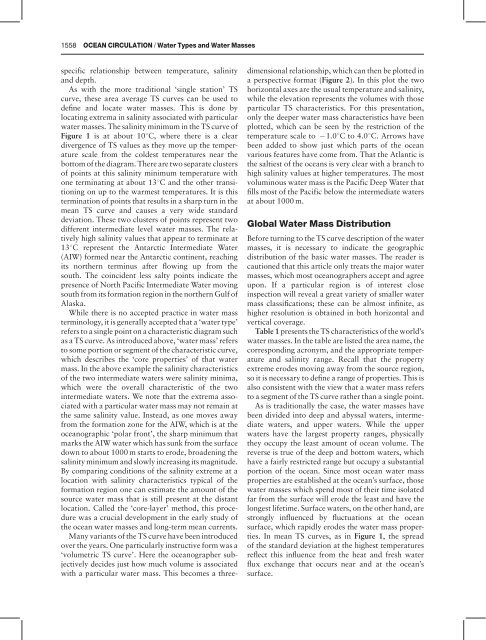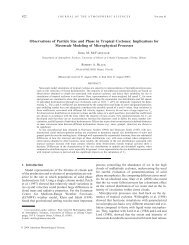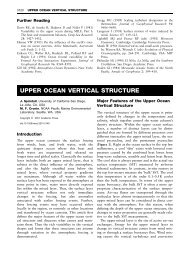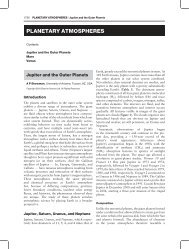Ocean Circulation - Water Types and Water Masses
Ocean Circulation - Water Types and Water Masses
Ocean Circulation - Water Types and Water Masses
You also want an ePaper? Increase the reach of your titles
YUMPU automatically turns print PDFs into web optimized ePapers that Google loves.
1558 OCEAN CIRCULATION / <strong>Water</strong> <strong>Types</strong> <strong>and</strong> <strong>Water</strong> <strong>Masses</strong><br />
specific relationship between temperature, salinity<br />
<strong>and</strong> depth.<br />
As with the more traditional ‘single station’ TS<br />
curve, these area average TS curves can be used to<br />
define <strong>and</strong> locate water masses. This is done by<br />
locating extrema in salinity associated with particular<br />
water masses. The salinity minimum in the TS curve of<br />
Figure 1 is at about 101C, where there is a clear<br />
divergence of TS values as they move up the temperature<br />
scale from the coldest temperatures near the<br />
bottom of the diagram. There are two separate clusters<br />
of points at this salinity minimum temperature with<br />
one terminating at about 131C <strong>and</strong> the other transitioning<br />
on up to the warmest temperatures. It is this<br />
termination of points that results in a sharp turn in the<br />
mean TS curve <strong>and</strong> causes a very wide st<strong>and</strong>ard<br />
deviation. These two clusters of points represent two<br />
different intermediate level water masses. The relatively<br />
high salinity values that appear to terminate at<br />
131C represent the Antarctic Intermediate <strong>Water</strong><br />
(AIW) formed near the Antarctic continent, reaching<br />
its northern terminus after flowing up from the<br />
south. The coincident less salty points indicate the<br />
presence of North Pacific Intermediate <strong>Water</strong> moving<br />
south from its formation region in the northern Gulf of<br />
Alaska.<br />
While there is no accepted practice in water mass<br />
terminology, it is generally accepted that a ‘water type’<br />
refers to a single point on a characteristic diagram such<br />
as a TS curve. As introduced above, ‘water mass’ refers<br />
to some portion or segment of the characteristic curve,<br />
which describes the ‘core properties’ of that water<br />
mass. In the above example the salinity characteristics<br />
of the two intermediate waters were salinity minima,<br />
which were the overall characteristic of the two<br />
intermediate waters. We note that the extrema associated<br />
with a particular water mass may not remain at<br />
the same salinity value. Instead, as one moves away<br />
from the formation zone for the AIW, which is at the<br />
oceanographic ‘polar front’, the sharp minimum that<br />
marks the AIW water which has sunk from the surface<br />
down to about 1000 m starts to erode, broadening the<br />
salinity minimum <strong>and</strong> slowly increasing its magnitude.<br />
By comparing conditions of the salinity extreme at a<br />
location with salinity characteristics typical of the<br />
formation region one can estimate the amount of the<br />
source water mass that is still present at the distant<br />
location. Called the ‘core-layer’ method, this procedure<br />
was a crucial development in the early study of<br />
the ocean water masses <strong>and</strong> long-term mean currents.<br />
Many variants of the TS curve have been introduced<br />
over the years. One particularly instructive form was a<br />
‘volumetric TS curve’. Here the oceanographer subjectively<br />
decides just how much volume is associated<br />
with a particular water mass. This becomes a threedimensional<br />
relationship, which can then be plotted in<br />
a perspective format (Figure 2). In this plot the two<br />
horizontal axes are the usual temperature <strong>and</strong> salinity,<br />
while the elevation represents the volumes with those<br />
particular TS characteristics. For this presentation,<br />
only the deeper water mass characteristics have been<br />
plotted, which can be seen by the restriction of the<br />
temperature scale to 1.01C to 4.01C. Arrows have<br />
been added to show just which parts of the ocean<br />
various features have come from. That the Atlantic is<br />
the saltiest of the oceans is very clear with a branch to<br />
high salinity values at higher temperatures. The most<br />
voluminous water mass is the Pacific Deep <strong>Water</strong> that<br />
fills most of the Pacific below the intermediate waters<br />
at about 1000 m.<br />
Global <strong>Water</strong> Mass Distribution<br />
Before turning to the TS curve description of the water<br />
masses, it is necessary to indicate the geographic<br />
distribution of the basic water masses. The reader is<br />
cautioned that this article only treats the major water<br />
masses, which most oceanographers accept <strong>and</strong> agree<br />
upon. If a particular region is of interest close<br />
inspection will reveal a great variety of smaller water<br />
mass classifications; these can be almost infinite, as<br />
higher resolution is obtained in both horizontal <strong>and</strong><br />
vertical coverage.<br />
Table 1 presents the TS characteristics of the world’s<br />
water masses. In the table are listed the area name, the<br />
corresponding acronym, <strong>and</strong> the appropriate temperature<br />
<strong>and</strong> salinity range. Recall that the property<br />
extreme erodes moving away from the source region,<br />
so it is necessary to define a range of properties. This is<br />
also consistent with the view that a water mass refers<br />
to a segment of the TS curve rather than a single point.<br />
As is traditionally the case, the water masses have<br />
been divided into deep <strong>and</strong> abyssal waters, intermediate<br />
waters, <strong>and</strong> upper waters. While the upper<br />
waters have the largest property ranges, physically<br />
they occupy the least amount of ocean volume. The<br />
reverse is true of the deep <strong>and</strong> bottom waters, which<br />
have a fairly restricted range but occupy a substantial<br />
portion of the ocean. Since most ocean water mass<br />
properties are established at the ocean’s surface, those<br />
water masses which spend most of their time isolated<br />
far from the surface will erode the least <strong>and</strong> have the<br />
longest lifetime. Surface waters, on the other h<strong>and</strong>, are<br />
strongly influenced by fluctuations at the ocean<br />
surface, which rapidly erodes the water mass properties.<br />
In mean TS curves, as in Figure 1, the spread<br />
of the st<strong>and</strong>ard deviation at the highest temperatures<br />
reflect this influence from the heat <strong>and</strong> fresh water<br />
flux exchange that occurs near <strong>and</strong> at the ocean’s<br />
surface.








![Chapt 2.5 [PDF]](https://img.yumpu.com/24218624/1/190x146/chapt-25-pdf.jpg?quality=85)